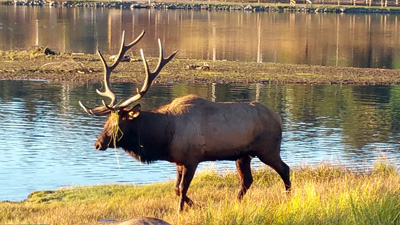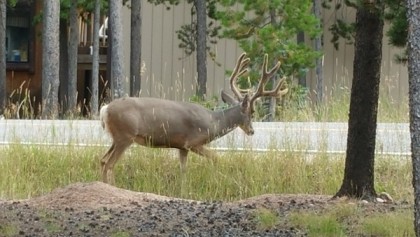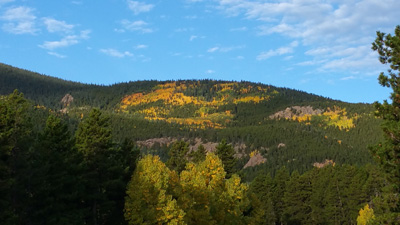Mabon Moon of the First Snow
 When I went into Evergreen yesterday, just after turning off Brook Forest Drive I went past a house that had a bull elk and his harem resting in their front yard, maybe 15 does. A stream runs between the highway and this house. The trees gave shade from the brutal morning sun. A domestic scene with wild animals. It came to my attention when a large bulk moving caught my peripheral vision. That’s the paleolithic helping in the here and now.
When I went into Evergreen yesterday, just after turning off Brook Forest Drive I went past a house that had a bull elk and his harem resting in their front yard, maybe 15 does. A stream runs between the highway and this house. The trees gave shade from the brutal morning sun. A domestic scene with wild animals. It came to my attention when a large bulk moving caught my peripheral vision. That’s the paleolithic helping in the here and now.
It amuses me, when I go to Evergreen, to see the number of people who gather at the lake. All these wonderful mountains and the locals come to look at the water. I imagine only a former native of a water rich state would notice the irony.
 Vertical and flat. Humid and arid. Those are the big differences between our new home and our old one. Here I drive through canyons, over high passes, around stands of rock with the view often limited to a few hundred feet on either side, sometimes less than that. When we leave Conifer and go into Denver though, we immediately return to the far horizons common to the midwest. We frequently transit between the great plains and the mountain west, living as we do in the borderlands between the two.
Vertical and flat. Humid and arid. Those are the big differences between our new home and our old one. Here I drive through canyons, over high passes, around stands of rock with the view often limited to a few hundred feet on either side, sometimes less than that. When we leave Conifer and go into Denver though, we immediately return to the far horizons common to the midwest. We frequently transit between the great plains and the mountain west, living as we do in the borderlands between the two.
Though we have had a wet summer and somewhat wet fall, when the rains cease, things dry out fast. We can go from low fire danger to high in a day. That’s why fire mitigation is constantly on my mind.

When verticality and aridity intersect, as they do at 8,800 feet and above, a genuinely unfamiliar biosphere is the result. Unfamiliar to those from the rainy flatlands of middle America, that is. On Shadow Mountain we have two trees: lodgepole and aspen. Along streams there are more species of tree and shrub and there are microclimates that might support greater diversity, but on the bulk of the land that can grow anything, lodgepole and aspen. There are grasses, flowers, a few shrubs as understory, but just as often the rocky ground is bare. The mountains have strict limitations for plants.
The plant limits determine the fauna, too. Grass eaters like mule deer and elk do well, as do predators who eat them. There are small mammals that are prey for foxes and coyotes, but there are surprisingly few insects. That limits the birds. We have raven, crow, Canada and blue jays, the occasional robin, birds of prey that feed off food similar to that preferred by foxes and coyotes and other game birds. There are, as well, black bears. We’ve seen all of these save the bear.
Still learning about the mountains. Will not stop.
